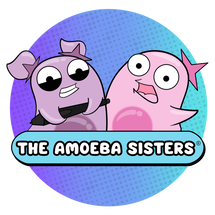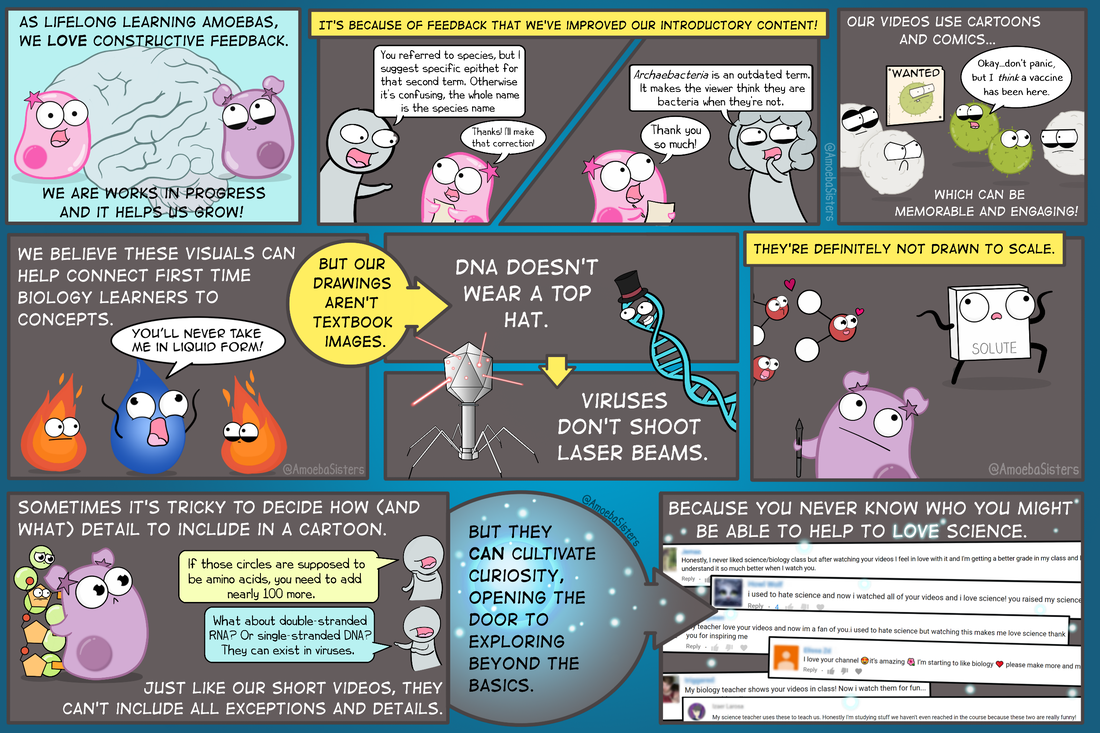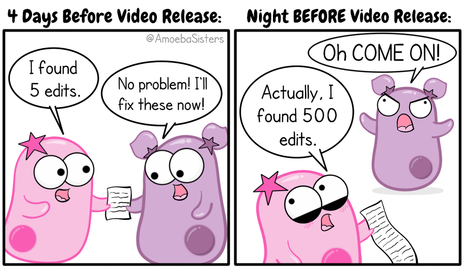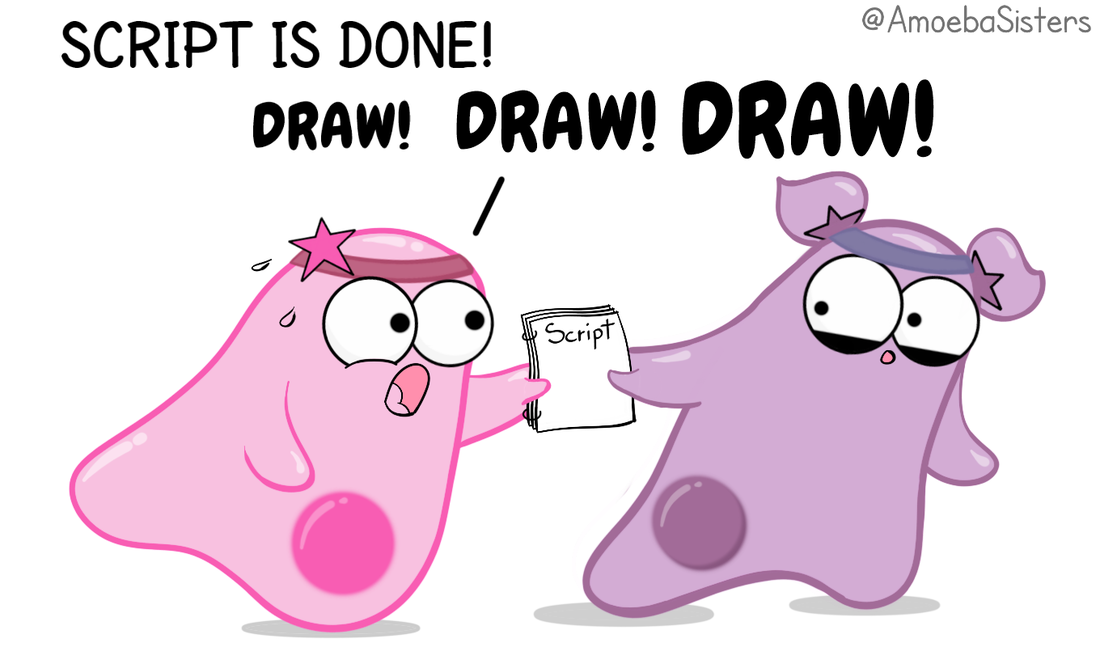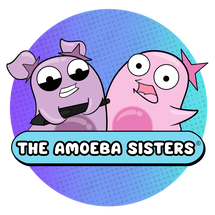|
What are the "Amoeba Sisters" videos?
A series of short, FREE science videos that demystify science with humor, relevance, and a lot of comics to help students connect to the content (drawn by Petunia). These educational videos center on Pinky's experience and certification in teaching science at the high school level. Secondary life science, specifically, is Pinky's passion. Her Texas teacher certification includes grades 8-12 composite science (encompassing biology, chemistry, and physics). You can learn more general information about our work here. |
|
Our Amoeba Sisters videos:
Where do I find all of your videos?
All of our videos are on our YouTube channel, and we suggest bookmarking our Amoeba Sisters YouTube Biology Learning Playlist. We also have our YouTube Shorts playlist (most of them address an isolated biology concept in under 60 seconds). Please subscribe to our channel to be notified when we create a new video! Since YouTube is our chosen platform, check out are 10 tips for using YouTube for use with edu videos.
Why did you start creating these videos?
In 2013, Pinky was reflecting on her time teaching in the high school biology classroom and was looking for a way to help make the lengthy traditional lectures she was accustomed to using less...lengthy. She had observed that it was often during her traditional lectures and notes where she found her students' curiosity dwindled and more classroom management challenges arose, at least in her classroom. She mentioned this to her sister, Petunia, one summer evening, and the brainstorming session resulted in an idea for making a video on enzymes. While it was originally just for that one video, receiving feedback that it was helping others was motivating and eventually resulted in developing a channel. You can learn more about the very beginnings of our channel here.
- are all FREE and hosted on our Amoeba Sisters YouTube Channel.
- most are less than 10 minutes to provide a foundation and give more time for the important things: class discussion, exploration, hands-on labs, and student creation!
- are organized in sequence in our learning playlist
- have subtitles [click the CC button at bottom right of any of our videos in YouTube], in order to help make them more accessible.
- offer many translated subtitles! There are over 22 languages represented in translated subtitles (thanks to our awesome community)! Learn more about translations here.
- work with resources that we create (all listed here), including our handouts and Unlectured Series
- focus on the Texas science TEKS (although videos can include content in science standards outside of Texas)
Where do I find all of your videos?
All of our videos are on our YouTube channel, and we suggest bookmarking our Amoeba Sisters YouTube Biology Learning Playlist. We also have our YouTube Shorts playlist (most of them address an isolated biology concept in under 60 seconds). Please subscribe to our channel to be notified when we create a new video! Since YouTube is our chosen platform, check out are 10 tips for using YouTube for use with edu videos.
Why did you start creating these videos?
In 2013, Pinky was reflecting on her time teaching in the high school biology classroom and was looking for a way to help make the lengthy traditional lectures she was accustomed to using less...lengthy. She had observed that it was often during her traditional lectures and notes where she found her students' curiosity dwindled and more classroom management challenges arose, at least in her classroom. She mentioned this to her sister, Petunia, one summer evening, and the brainstorming session resulted in an idea for making a video on enzymes. While it was originally just for that one video, receiving feedback that it was helping others was motivating and eventually resulted in developing a channel. You can learn more about the very beginnings of our channel here.
What grade levels are your videos designed for?
Our videos are for anyone wanting to learn biology! Our focus is high school biology (as Pinky is a former high school biology teacher), but we receive feedback that some of our videos are useful for other levels that are covering these topics, including introductory biology at the college level. In our community tab survey in late 2019, we were excited to find 37% of the responding 26,000 viewers are using our videos to help with their college-level biology courses. All of our videos can be found in our official biology playlist for browsing, but we also started listing our advanced concepts additionally in another playlist to make searching easier.
There is more involved in DNA replication/ protein synthesis/ etc. than your video includes!
Definitely. We frequently remind viewers that we cannot include all of the exceptions and details in a video under 10 minutes! Additionally, our videos are unique in that they use comics and cartoons. We find them to be memorable (and often humorous) visuals to the content, but we emphasize they're not scientific illustrations. Meaning, nitrogen and carbon don't tap dance. Our illustrated cell and molecule cartoons are definitely not to scale. Ribosomes don't have a mustache. DNA is usually a right-handed double helix and it doesn't have eyes...a face...or a top hat... see our infocomic below!
Our videos are for anyone wanting to learn biology! Our focus is high school biology (as Pinky is a former high school biology teacher), but we receive feedback that some of our videos are useful for other levels that are covering these topics, including introductory biology at the college level. In our community tab survey in late 2019, we were excited to find 37% of the responding 26,000 viewers are using our videos to help with their college-level biology courses. All of our videos can be found in our official biology playlist for browsing, but we also started listing our advanced concepts additionally in another playlist to make searching easier.
There is more involved in DNA replication/ protein synthesis/ etc. than your video includes!
Definitely. We frequently remind viewers that we cannot include all of the exceptions and details in a video under 10 minutes! Additionally, our videos are unique in that they use comics and cartoons. We find them to be memorable (and often humorous) visuals to the content, but we emphasize they're not scientific illustrations. Meaning, nitrogen and carbon don't tap dance. Our illustrated cell and molecule cartoons are definitely not to scale. Ribosomes don't have a mustache. DNA is usually a right-handed double helix and it doesn't have eyes...a face...or a top hat... see our infocomic below!
I have more questions about issues where YouTube is blocked, how I can use your videos, how I can view translations, and the resources that go with your videos?
Check out our "Common Questions and Answers About Our Videos" below! Have a different question from what is listed below? You can also contact us.
Check out our "Common Questions and Answers About Our Videos" below! Have a different question from what is listed below? You can also contact us.
Common Questions and Answers About Our Videos
What if YouTube is completely blocked in my school/district?
YouTube is one of the largest global video sharing platforms available, and it offers many educational videos exclusively on its platform. In cases where a school district or institution opts to block YouTube but would still like to utilize our videos, there are several options outlined below:
Option 1:
Option 2:
Option 3:
Overall, this is a determination that needs to be discussed and evaluated within a district to make a decision that is best for them. If choosing to use our videos, a reminder that our actual video files (or recordings of our videos) cannot be uploaded into other platforms as outlined in our terms of use. They must be either linked to or embedded from our YouTube channel using the YouTube embed code.
Option 1:
- YouTube has a link to share how specific videos or entire channels can be approved on a school network while blocking all other content. YouTube even provides a support page on this topic that educators can send to their IT staff. YouTube additionally offers a restricted mode for devices which hides comments and blocks content that it labels as inappropriate.
Option 2:
- We can also be found on the YouTube Player for Education. YouTube Player for Education (a player by YouTube) is marketed to LMS and edtech platforms (example: the edtech platform Edpuzzle integrates the player). For LMS and edtech platforms that choose to integrate the YouTube Player for Education, it feeds from a different domain than YouTube. This means our videos (and other edu videos from YouTube) can play even if the entire YouTube platform is blocked on a district filter. The YouTube Player for Education also has NO ads, comments, or distractions. If your school district uses a edtech platform or LMS that doesn't currently integrate the YouTube Player for Education (or if you're unsure whether they do or not), you can reach out to that platform or LMS asking them to consider it. You can also contact us for more information. Our email button is at the bottom of this page.
Option 3:
- We are licensed on Boclips, which is completely separate from YouTube. Boclips can provide different ways a district can use our licensed content (as well as many other edu creators that license on Boclips) separate from YouTube. You can contact Boclips for assistance here.
Overall, this is a determination that needs to be discussed and evaluated within a district to make a decision that is best for them. If choosing to use our videos, a reminder that our actual video files (or recordings of our videos) cannot be uploaded into other platforms as outlined in our terms of use. They must be either linked to or embedded from our YouTube channel using the YouTube embed code.
YouTube is not blocked on my internet network, but I'm still not able to see one or more of your videos?
Here are two potential reasons this could be happening:
(1) You may be playing the video within a school/district network or on a school/district device that made a change to their filter settings. Depending on filter changes, this can affect the ability to view some videos on YouTube. We do want to point out that enabling YouTube's "standard" restricted mode (which many school districts like to use to block inappropriate videos/YouTube comments) will not affect our videos. Our videos will still play on YouTube's "standard" restricted mode! However, some districts and institutions enable additional filtering in addition to YouTube's standard restricted mode that can affect viewing of videos, including ours, on YouTube. This information here in this blog from Google may be helpful. It shows how a school district can choose to turn on the ability to view certain videos/enable certain channels on their settings even if they have turned on a more strict filter setting. School districts may not be aware of these controls and sharing this with your tech department may provide a solution. Not sure if what you are experiencing is related to filtering? Check to see if videos are missing or inaccessible from our official playlist- as of January 2021, we have over 78 videos there (with an additional video typically added every month or two).
(2) Are you getting a message that the video cannot be viewed on your own personal device away from your school/district network? Check out this information from YouTube with some potential fixes related to browser errors or internet speed here.
(1) You may be playing the video within a school/district network or on a school/district device that made a change to their filter settings. Depending on filter changes, this can affect the ability to view some videos on YouTube. We do want to point out that enabling YouTube's "standard" restricted mode (which many school districts like to use to block inappropriate videos/YouTube comments) will not affect our videos. Our videos will still play on YouTube's "standard" restricted mode! However, some districts and institutions enable additional filtering in addition to YouTube's standard restricted mode that can affect viewing of videos, including ours, on YouTube. This information here in this blog from Google may be helpful. It shows how a school district can choose to turn on the ability to view certain videos/enable certain channels on their settings even if they have turned on a more strict filter setting. School districts may not be aware of these controls and sharing this with your tech department may provide a solution. Not sure if what you are experiencing is related to filtering? Check to see if videos are missing or inaccessible from our official playlist- as of January 2021, we have over 78 videos there (with an additional video typically added every month or two).
(2) Are you getting a message that the video cannot be viewed on your own personal device away from your school/district network? Check out this information from YouTube with some potential fixes related to browser errors or internet speed here.
I teach online or have a blended learning course. Can I post your videos?
We have this addressed in our terms of use, but we can also summarize it here. Linking to our video on YouTube or using the YouTube embed code (which looks nicer in most learning management systems) is just fine! All of our videos enable the embed feature from YouTube as this allows our videos to play within a website/platform/presentation without having to navigate to the actual YouTube website.
However, uploading our video file---or a screen recording of our video---is prohibited. Our videos may only be hosted through our YouTube channel. Our terms of use page explains why uploading screen recordings of our video or our actual video files onto other websites/platforms (called "freebooting") is so harmful to YouTube creators. We should also mention that occasionally we make important edits or clarification cards to our videos- these are never visible on a stolen video since it isn't playing through our YouTube channel where the edit or clarification card was made.
However, uploading our video file---or a screen recording of our video---is prohibited. Our videos may only be hosted through our YouTube channel. Our terms of use page explains why uploading screen recordings of our video or our actual video files onto other websites/platforms (called "freebooting") is so harmful to YouTube creators. We should also mention that occasionally we make important edits or clarification cards to our videos- these are never visible on a stolen video since it isn't playing through our YouTube channel where the edit or clarification card was made.
Since you first started in 2013, do you delete old videos?
Generally not ---with rare exceptions if we identify a major issue/error within a video. In fact, you can find our original first video on enzymes from the very beginning that we created in 2013, despite this video being updated years later. We learned that deleting old videos causes a serious inconvenience as existing video links/YouTube embed codes will not function. Besides not wanting to destroy the YouTube link, we choose to not delete our old videos because we want people to know how much we've improved as creators by sheer practice. When we update an old video, we leave the video up, and we put in parenthesis "(Old Video)" next to the title so that viewers know there is an updated one available that they can choose to watch instead. While old videos may not show in our biology playlist, this does not affect the video link or video embed code as the old videos are still present.
So how do you handle video edits or corrections?
We have a blog post here about how we handle this. Feedback regarding a need for a clarification or a mistake that we missed is very important to us as it continues to help us improve our work!
You cover the basics of what I'm learning in my course. Do you have a recommended reference where I can learn more?
It's important to question information that you find online. If you're looking for a textbook reference for science information (and to explore more about any concept), we highly recommend the FREE, peer-reviewed textbook OpenStax: https://openstax.org/details/books/biology. We list OpenStax as a suggested reference in our video details for anyone wanting to learn more beyond our secondary science concepts as Pinky has found it to be an excellent resource for biology fact checking. She also thinks the concept of an OER textbook is amazing. With a few of our more advanced concepts, we additionally include "further reading" suggestions in the video details which suggest science journals or resources. While our science videos cover life science concepts that are typically covered in secondary science textbooks (and something that Pinky has experience with teaching throughout the years), the way we address science concepts is a bit...different.
How do I check to see if you have a video on a specific topic?
If we have it, it's in our official Amoeba Sisters YouTube video playlist. Would you like to see a printable list of videos in our playlist? We have that on our Playlist page. You can subscribe to our channel to be notified when we release a new video (which is then added to that playlist).
I notice that many of your videos have resources that go with them?
Yes! Please see our Google Sheet which lists all of our videos and the resources we created that complement them. We are frequently updating it.
How can I translate your videos? And how do I see translated subtitles for your videos?
|
Thank you so much for your interest in translating our video subtitles!
Please see our page here: our community has helped translate our video subtitles into over 22 languages! In addition, the audio in our videos have been dubbed by Aloud in three different languages: Spanish, Portuguese, and Hindi. Learn more about that here. Please note that we do not allow dubbing by others or reuploading of our videos on other channels as we outline here on our terms of use. |
How do view translated subtitles?
Please see silent screenshot video above. |
I've seen your videos embedded on edtech platforms such as Edpuzzle or Nearpod. Do you allow this?
As Pinky is a former classroom teacher, we know some platforms and tools such as Edpuzzle and Nearpod have great features for making edu YouTube videos more engaging! While platforms like Edpuzzle and Nearpod can use our videos IF using the YouTube embed code, our videos can't be downloaded from our YouTube channel and then uploaded to a platform or edtech tool itself. This is due to our licensing agreement which helps protect our videos (and some of the special permissions that we obtain for things like music that may be only permitted on the YouTube platform). You can learn more on our terms of use page. We do not create nor endorse any questions that may use our YouTube embedded videos on edtech platforms such as Edpuzzle and Nearpod, and we have no affiliation with either platform.
The problem we run into is if our videos are actually uploaded onto Edpuzzle, Nearpod, or other platforms. If you received a notification that a video was removed due to copyright, it’s likely that the video was actually uploaded onto the platform itself (instead of using the YouTube embed option). You can check with the edtech tool or platform to confirm. But keep in mind most platforms and edtech tools including (but not limited to) Google Docs/Slides, Edpuzzle, Nearpod, Schoology, Blackboard, Google Classroom, and Canvas do have an “embed from YouTube” option that you can opt to use with our videos and works well for our terms of use! Doing an internet search with the name of the edtech tool or platform with the phrase “how to embed a video from YouTube” can provide instructions for how to embed from YouTube in order to avoid this concern.
The problem we run into is if our videos are actually uploaded onto Edpuzzle, Nearpod, or other platforms. If you received a notification that a video was removed due to copyright, it’s likely that the video was actually uploaded onto the platform itself (instead of using the YouTube embed option). You can check with the edtech tool or platform to confirm. But keep in mind most platforms and edtech tools including (but not limited to) Google Docs/Slides, Edpuzzle, Nearpod, Schoology, Blackboard, Google Classroom, and Canvas do have an “embed from YouTube” option that you can opt to use with our videos and works well for our terms of use! Doing an internet search with the name of the edtech tool or platform with the phrase “how to embed a video from YouTube” can provide instructions for how to embed from YouTube in order to avoid this concern.
May I request a topic for a future video?
We appreciate biology topic suggestions! You can definitely suggest topics on our social media pages, and sometimes we have community votes from those topics. Our favorite location to interact with our community is on our YouTube community tab.
How often do you release a video?
|
We try to release a video at least once a month. We'd love to go faster, but the amount of edits that Pinky finds is inversely proportional to the amount of time before the release. If you would like to be notified every time we release a video, please subscribe to our channel.
|
I represent an educational business. Do you license your videos?
For businesses interested in licensing our videos for their use, please contact Boclips here, who handles such licenses on our behalf.
Which tools are you currently using to make your videos?
|
We are not fancy. Our first videos started with programs such as Windows Paint (free), Windows Moviemaker (free), and a cell phone to record audio. This old tutorial video shows how we made many of our older videos, and you can see our milestones to see how we started. Our more recent videos have transitioned to some other software/hardware. Here is how we make our content currently. If you are considering creating videos, or having students create videos, realize that there are so many options. Check out our Student Creators page.
|
Do you do any presentations at conferences that involve your videos?
